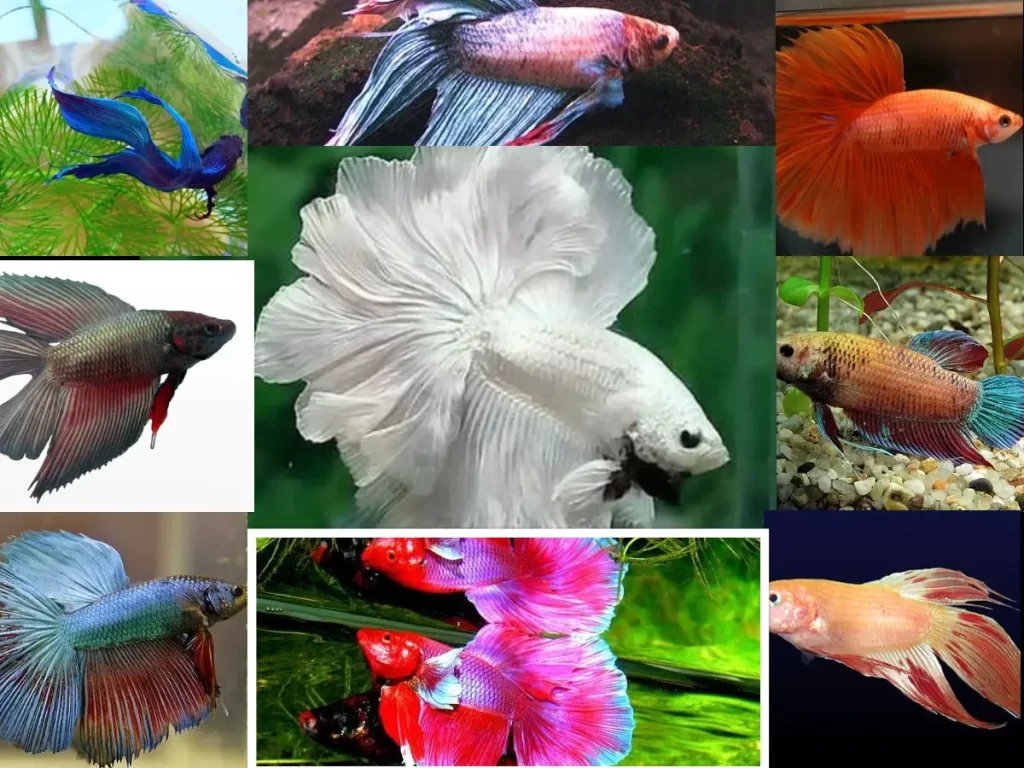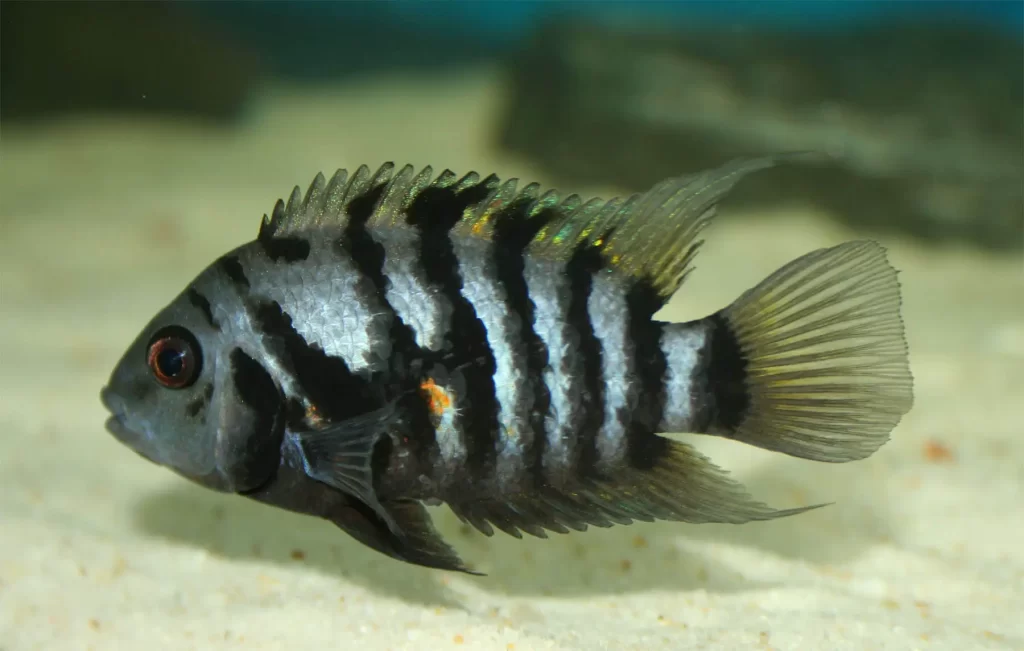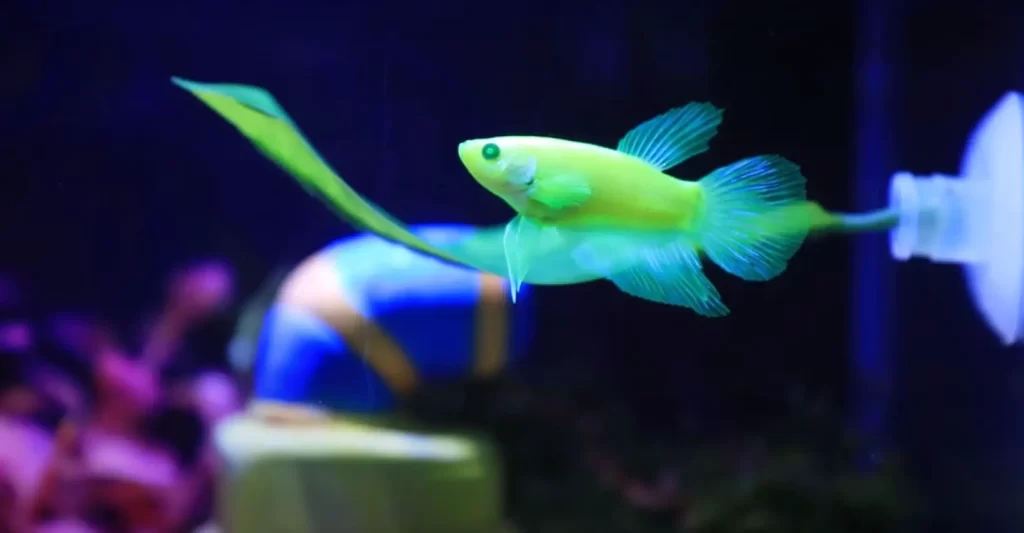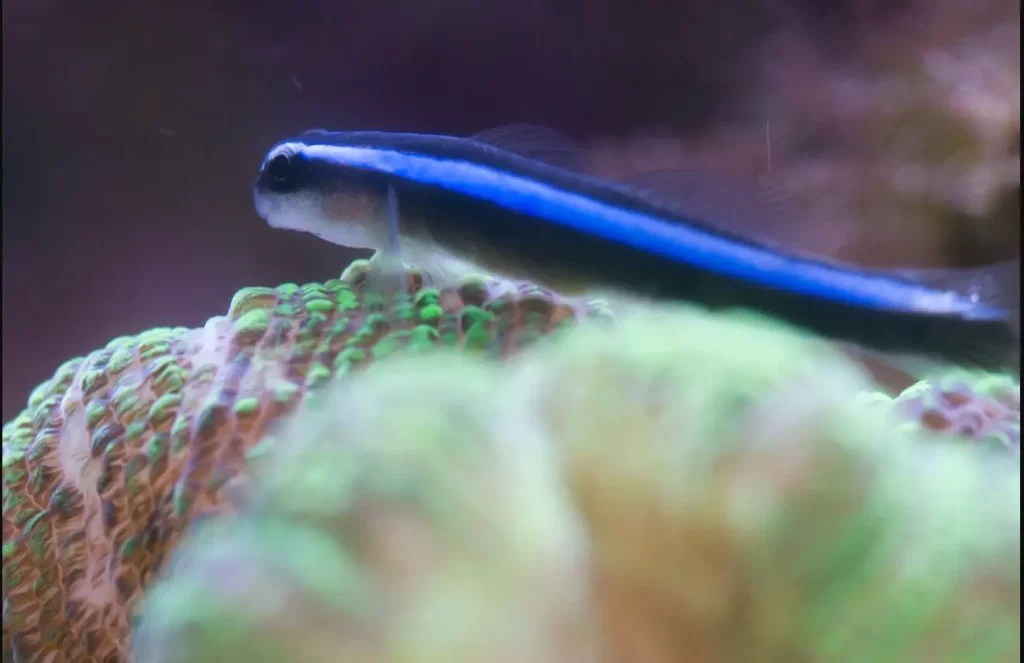Betta Fish are stunning fish that you can keep as a pet. They come in a wide variety of colors like red, orange, green, etc., color patterns like black orchid, pineapple, dragon scale, etc., and tale types like double tail, half-moon, rose tail, etc. Keeping them as a pet in your home or office will brighten up your space. You might have seen the standard variant of betta ish like red color patterns or the blue but do you know about all the Betta Fish colors and color patterns that are available for you to purchase?
In this article we have divided the color pattern into two categories, one category will have a list of betta with a single color variant and the second category will have betta with a multi-color variant.
Color Pattern:
Single Color Betta: black, melano, black lace, red, white, yellow, pink, purple, green, orange, solid, albino, opaque, cellophane, copper, and Gold.
Multi-color Betta: Bi-colored, black orchid, pineapple, Turquoise, metallic or copper black, rose petal, mustard gas, wild-type, chocolate, dragon scale, butterfly, marble, Cambodian, piebald, koi, mask, multi-colored and Thai flag.
Background
The Bettas were discovered in the South-East Asian Countries like Thailand, Malaysia, Indonesia, and introduced to Singapore. They are members of the Gourami family. They live in rice paddies, shallow ponds/streams, and drainages. Betta eats insect eggs and larvae. Natural calamities like storms/ floods and droughts occur in their inhabitant location. So they have a unique ability to breathe oxygen directly from the air through their gills. Bettas can live outside water for a short period. They take in the air if it is moist. Hence, they are known as Labyrinth fish.
Bettas got their name after they got famous in the mid-1800s from the ancient Asian warriors called Bettah. It is pronounced as Bet-tah (My fish is better than yours). The bravery of the fish determined the bet between commentators. The former King of Siam himself regulated and taxed them. Bettas are called Plakat(Biting fish) in its native, Thailand(formerly Siam). Hence, the Siamese fighting fish was named. They are considered as The Jewel of the Orient.
Bettas are non-nocturnal like us. It means they are active during the day and need a good nap at night. Bettas are sensitive and need extra care for their healthy existence.
Different Betta Fish Colors and Color Patterns
Betta Breeding has continued over so many years to create a wider range of different but similar-looking fish. Even the fishkeeper can fail to recognize the exact type because of the selective breeding processes happening every year. It has exceeded over 73 astonishing varieties to date.
For you to understand deeply about the colors and color patterns we have divided it into two categories. The first section will be all about single-colored bettas or single color variants and the second section will be about the color patterns.
Division of Betta Fish With Single Color
in this section, we will be looking into the type so betta with a single color variation.
Black
Black Bettas have a dark black coloration in their body. However, we can see Purple or Blue highlights as well. Some variations of Black Bettas are mentioned below:
Melano
Melanos have the darkest Black shade and are the most popular. They are infertile. Other Melano gene carriers can only breed the Melano offspring. They have a particular type of gene in them that increases the black pigment in their skin, making them the darkest black-colored fish.
Black Lace
They have less dark coloration in comparison to the Melanosis. Laces are very easy to breed as they are more fertile. Their fins are transparent and smoky, which gives them the lacy appearance. They have high radiance in their body.
Red
Red is the most dominant color in Betta fish color. Sometimes, the redness disappears and seems washed off. The fishkeeper should be extra careful with their diet and water conditions during such times as those are the signs of their uneasiness and health degradation.
White
White Bettas are plain and dull in comparison to other coloration fish types. However, White Bettas are very magnificent and ravishing if chosen the best tail type. That means one can select the same white-colored fish with a selection of any tail type as per their wish.
Yellow
Yellow Bettas have a full yellow-colored body, including their fins and tail as well. There are varieties from intensely yellow-colored Betta to softer or lighter versions as well. Red-colored Bettas and the Yellow ones have similar characteristics.
Pink
Pink Bettas have translucent/ transparent flesh as they have no pigments. They will look comparatively brighter if the pinkness is extended all over the body. Pink Bettas have various colors ranging from red-purple-white. The Albinos look similar to the Pink Bettas.
Purple
Purple Bettas are very hard or even impossible to find. It is one of the rarest types. However, an experiment between a royal blue male and a blue/red female [a Black devil and Melano geno cross] was done by some breeders in the past. A violet-blue offspring came as a result, so completely purple fish cannot be bred.
Green
Green Betta type is very rare as well because a complete green Betta is not found. It will be similar to Turquoise, and it will look similar to other dark-colored fish. We can see their glorious green shine in the light. Some true greens are seen through naked eyes and are bred after highly prized varieties.
Orange
Orange Betta is another rare fish type as a full-bodied orange Betta cannot be found. These fish have a rich tangerine shade. They appear red in bad lighting.
Solid
Solids are in the form of red. It is similar to the pattern of the Red Bettas. They have only one solid color throughout their body.
Albino
Albinos have solid white bodies with no pigmentation at all. They are an extremely rare fish type. People often misunderstand this fish as White Bettas but, their eye color differentiates them from each other. Albinos have either red or pink-colored eyes. They get blind at a very early age resulting in their scarcity as breeding them is very tough or impossible.
Opaque
Opaque does not mean fully white. They consist of Blue(Royal Blue), Steel blue, and Green colors. The steel-blue are the most common ones. They have features similar to White Bettas, so the term Opaque White is used. The white pigment does not blend well with the underlying yellow shade in their body, and they also have poor quality finnage. Opaques are less aggressive in comparison to other Bettas as well.
Clear/ Cellophane
Cellophane has transparent skin. They have no pigments at all, and their inside flesh gives them a shiny pinkish/fleshy color outlook. Their tails and fins are translucent as well. Kinds of Cellophane are misunderstood as Albinos as well, but Cellophane has black eyes. These fish are very useful in passing on strong finnage traits even if they lack colorations.
Copper
This type of fish comes in almost light gold or darker copper color with some red, blue, yellow, or even purple metallic shades. Copper Bettas have highly radiant features. We can see a glittering shine in their body in strong light while they appear silver-colored in a weakly lighted area.
Gold
Gold Bettas are yellow-colored fish, and they look like a piece of jewelry. They have metallic golden shine all over their body just like that of a golden statue. However, they prefer cooler water in comparison to other Betta fish types(74 Degree Fahrenheit).
Division of Betta Fish through Bi-color/Multi-color variation
Bi-colored
Bi-colored Bettas have two or more colors in their body and fins/tails. There are two types: Dark-colored has one of the six accepted dark solid colors in their body. Their tail/ fins should contrast themselves in light or even bright colors. Light-colored ones have lighter colored bodies, and their fins should be darker or even lighter.
Black Orchid
Black Orchids have a pitch-black body, but different colored fins make them a bicolored fish. The fins of Black Orchids have blue or red coloration. They have a blue or red half-circle of lines on their inner tails. Black Orchids are hard to breed, and they randomly appear from marble batches.
Pineapple
Pineapple Bettas are to Yellow Bettas. They have Yellow-colored bodies, but they have slight blackish shades on their fins, which makes them a bi-colored fish.
Turquoise
Turquoise Bettas have both green and blue mixture. It is hard to distinguish the exact color as it ends up looking somewhere between pale blue and pale green in a well radiant place. The fish keepers have to observe that they have more “green looking” features than blue to ascertain that they are Turquoise fish. It should not seem like they have yellowish shades when light falls into their body.
Metallic or Copper black
Metallic Bettas help in producing the black Melanosis. They have glorious radiance in their body. Their surface shells have thin crystal-like elements, so Steel blue, Royal Blue, or Turquoise colors are seen. They appear copper-bodied rather than steel-bodied due to the existing black features.
Rose Petal
Rose Petal is the rarest and the strangest type of Betta fish. This color bettas are famous for their extraordinarily beautiful fins and skin. They have a darker face and are found in generally electric lighter blue shades with some color distinctions (i.e., dark blue or Copper). They are extremely rare due to hardship while breeding.
Mustard Gas
Mustard Bettas have different colorations in their body and fins. Their body has a rich dark shade of either blue or green, and their fins are of the yellow or orange color. The shade of mustard blowing away in the form of a gas is due to the contrast in various colors. Chocolate Bettas are mistaken as Chocolate Bettas because they have similarities in their fin color.
Wild – type
These fish have radiant green or blue features with some bluish or reddish shades on their fins. Develop a wide range of colors and fins developed through selective breeding over time, resulting in the most beautiful combination of colors. Their behavior is quite the opposite of what their name indicates as they are not much aggressive and are a beautiful alternative to all other aggressive Bettas out there.
Orange Dalmatian
These Betta fish have freckles and spots all over their body. The color spots are orange as well. The body is covered with lighter orange while the fins are dark-colored with darker spots all over them. They are also known as “Apricot spots” or “Orange spotted Betta.”
Chocolate
Chocolate Bettas have a rich dark brown body like dark chocolates. They have the orange or yellow shade of coloration in their body, and their fins are yellow. The combination of Brown and Yellow has moved around for years now. They are similar to the Pineapple Bettas due to their similarity in Yellow-colored body and black colored scales.
Dragon Scale
Dragon scale Bettas have thick, hazy, metallic, and white scales in their body like a dragon. Some breeders bred them through selective processing of a different Betta called “Betta Mahachai” in Thailand. It became very popular after the genetic traits of this fish type mesmerized everyone with their glorious shine. The four layers of coloration (black layer, red layer, yellow layer, and the iridescent or blue layer.) merge with their body and resemble a dragon or a lizard.
Butterfly
Butterfly Bettas are another common type today after years of the selective breeding process. They are unique on their own and can easily be distinguished due to their beautiful fins. They have a solid body color up to the base of their fins and tail, which stops there, then a paler and iridescent color(often white or transparent) shades are seen. Male butterfly bettas can grow up to a maximum of 3 inches long, including their tails.
Marble
Marble Betta have various scratching color patterns in their body like that of real marble. They are famous for their color-changing genes, which are also referred to as “Transposons or jumping genes.” The main unique trait in them is to reinsert themselves into other Betta genes and change their function. They can jump through one chromosome gene to another as well.
Cambodian
They have a solid color in their body with different colored fins and tails. Cambodians have a light-toned body (usually white or flesh or pale pink), and their fins and tails are very bright colored (mostly red and other colors sometimes occur by themselves). They are discovered to have a single recessive gene within themselves, and they produce “pale pink light-colored fish” or “Unvollstaendige albino.” They are getting rarer due to less breeding in the past few years.
Piebald
Piebalds have bald spots on their heads. They have a pale-colored face(whitish or pinkish) with a solid dark-colored body and other brighter colored fins and tails. However, Piebalds have Butterfly and Marble patterning as well.
Koi
Koi Bettas have the coloration like that of a Marble betta(red, orange, and white). Kois was bred through a selective breeding process by aquarium hobbyists to protect their unique features and characteristics. They are bred to match them with the popular Koi Pond fish. Koi Bettas are very aggressive not only towards other males but with the females(if they try to go around the bubble nest) during the breeding process.
Mask
Mask Bettas do not have a darker face like other Bettas. It means that their face has the same coloration shade, just like their body. Half-masked Bettas have two colors in their head, and Full-masked Bettas have full blackface. Their body has different colors. Masks are not only seen in Turquoise, blue, and copper varieties but are found in other colorations as well.
Multi-colored
Multi-colored Bettas have a unique combination of 3 or more colors on their body. They do not fit into any other pattern type. They have a mixture of unpredictable and random genes and are unique Bettas.
Thai flag
Thai flag Bettas have the pattern of the Thai flag(red, white, and blue. They are the most expensive Betta fish. It was sold for 53,500 Baht( $1530) at an online store. However, We can see Butterfly or Marble patterns as well.
Conclusion
Betta fish are aggressive, so they need extra care. They require a minimum of 5 gallons tank. The price of the Betta fish differs from their type, coloration pattern, rarity, tail pattern, etc. But the ultimate price factor depends on the buyer itself:- how much he wants to spend. Generally, the cheapest Bettas cost between $3-5 or so. Some fish even cost up to $20. However, it gets expensive according to the rarity of the type. New types of color patterns are found due to the continuous selective breeding process happening every year.
Reference
Image Credit:
- https://en.wikipedia.org/wiki/en:Creative_Commons






